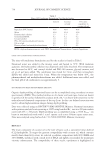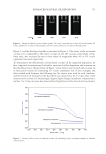711 Address all correspondence to Roger L. McMullen, rmcmullen@ashland.com Physicochemical Properties of Textured Hair ROGER L. MCMULLEN, TIMOTHY GILLECE AND TYLER SCHIESS Ashland LLC, Bridgewater, New Jersey, USA (R.L.M., T.G., T.S.) Synopsis In this study, we investigated differences in the various properties of textured hair as compared to straight hair. As representative hair types from both ends of the spectrum, we investigated the morphological and ultrafine structural characteristics of African and Caucasian hair. We took a profound look at African hair using field emission scanning electron microscopy (FESEM), examining the exterior of the fiber as well as its interior structure by analyzing thin cross-sections of hair. We found that it has unique morphology in both the exterior and interior of the fiber. Some key features include the fiber morphology at a point of curvature, concavity in the major axis, large distribution of melanin granules, and fibrillar structures (keratins) heavily coated with biological material (presumably lipids). We further examined the lipid characteristics of African and Caucasian hair using Fourier transform infrared imaging to map the lipid distribution within the cross- section of hair. Using dynamic vapor sorption, we observed the effect of lipid distribution in African hair and its influence on water management properties. Finally, tensile strength data (break stress, percentage extension at break, etc.) agreed with data previously published in the literature. Expanding on this theme, we monitored the fracture patterns of fibers extended to break using FESEM. Overall, African hair was found to exhibit various types of fracture patterns, especially at the point of curvature of the fiber. The structures of the broken fibrillar proteins (intermediate filaments) were significantly longer in Caucasian hair than in African hair. INTRODUCTION Textured hair refers to hair types that have some degree of curl, twist, wave, or coil associated with them. Hair from African descent, which is the most elliptical of all human hair types, represents one limit of the textured spectrum. Some types of Asian or Caucasian straight hair, which have more circular cross-sectional shapes, are at the other limit of the texture spectrum. Hair from various ethnicities or racial origins have unique physicochemical properties (1–5). For example, African hair has a lower radial swelling rate than Asian and Caucasian hair. In terms of mechanical (tensile) properties, it is generally found that the stress and elongation at break is lower in African hair than in Asian and Caucasian hair (6). The fracture point of the fiber in African hair during tensile measurements can occur in the twist or homogenous region of the fiber, although it more often appears in the twist region (7). African hair fibers with a larger diameter tend to have looser curl, while fibers with J. Cosmet. Sci., 72, 711–731 (November/December 2021)
712 JOURNAL OF COSMETIC SCIENCE thinner diameters tend to have tighter curl. It has also been shown that the lipid content in African hair is greater than in other hair types (8–10). Developing an understanding of hair curvature has challenged scientists for some time and has led to a significant amount of work in this area (11–20). A number of hypotheses have been proposed to explain hair curvature, and they involve follicle anatomy, asymmetric expression of structural keratins in the precortex, variable cortical shape, keratin filament orientation (relative to the hair growth axis), asymmetric proliferation in cells that form the inner and outer root sheaths, and dermal papilla asymmetry (21). Examining single fibers, the intrinsic optical properties (luster) of hair obtained from various ethnic origins were determined by researchers at TRI Princeton (22). They found that African and Indian hair had the greatest luster however, it should be noted that the degree of hair color greatly influences the outcome of such results. Also, they carried out goniophotometer measurements of single stretched fibers. Luster measurements carried out on hair in its natural state are more realistic and reflect the complexity of the hair fiber assembly and its contributions to the overall optical properties, especially in textured hair (23). Interestingly, the amino acid composition is the same for all hair types, which has been reported in several studies (24,25). A proteomics study of South Africans of indigenous African, Indian, Caucasian, and mixed ancestry was completed and identified several different protein classes (keratins, keratin-associated proteins, histone proteins, and desmosomes) in hair. However, they were unable to find a quantitative distinction between the different proteins found in each group of subjects (26). But a genome-wide association test of people living in Latin America with mixed European, Native American, and African ancestry reported a substitution on the PRSS53 protein from the protease serine S1 family that is associated with scalp hair curvature (27). As the traditional continental boundaries of race diminish, proteomics and genomics studies are becoming more important in identifying hair traits associated with racial ancestry. One of the principal motivations for understanding the behavior and physicochemical properties of textured hair stems from unique cosmetic treatment protocols that are used by populations with these hair types. For example, hair straightening and relaxing remain popular hair procedures to modify the overall 3D structure of hair fiber assemblies. Historically, interest in elucidating structural changes to the hair fiber associated with these treatments led to a better understanding of overall hair damage (28–32). MATERIALS AND METHODS Studies were carried out on dark brown European (Caucasian) and two types of African hair purchased from International Hair Importers and Products Inc. (Glendale, NY) and DeMeo Brothers, Inc. (Passaic, NJ). The European hair and one type of African hair (referred to as tightly curled African hair throughout the text) were obtained from International Hair Importers and Products Inc. We purchased another type of African hair (referred to as extremely tightly curled African hair) from DeMeo Brothers, Inc. For the analyses, many fibers were collected from a single hair tress for each hair type. While the Caucasian hair was blended, the African hair types came from one individual. Before analysis, all hair was washed with a 3% (w/w) sodium laureth sulfate:cocamidopropyl betaine (12:2) mixture.
Purchased for the exclusive use of nofirst nolast (unknown) From: SCC Media Library & Resource Center (library.scconline.org)






































































































































